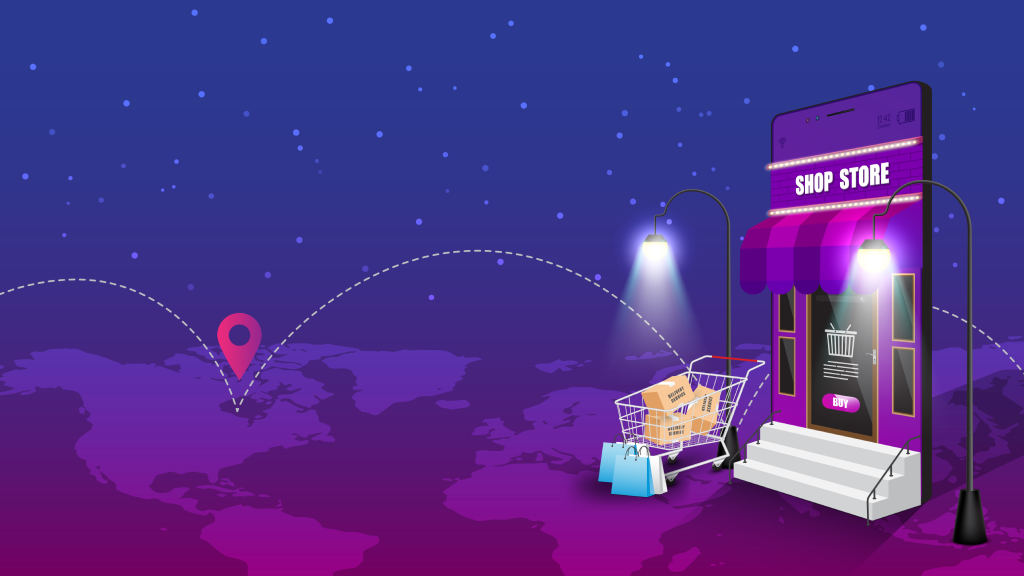Table of Contents
ToggleIn today’s fast-paced digital world, international shopping apps have become the cornerstone of cross-border eCommerce. With the rise of globalization and digital convenience, users can now easily buy and sell products across the globe through mobile platforms.
Several companies offer solutions for international shopping apps, but platforms like AliExpress stands out. They have successfully built a scalable multi-vendor eCommerce platform that connects millions of buyers and sellers worldwide every day.
But the question remains — how do you build a shopping app like AliExpress?
This blog will guide you through the entire process — from understanding the business model and essential features to selecting the right tech stack and how AlphaKlick can help turn your vision into a global marketplace.
What is an International Shopping App?
An international shopping app allows users to purchase products from global sellers. These mobile apps are designed to facilitate cross-border eCommerce, offering features like multi-language support, international currency handling, global shipping, and multiple payment gateway integrations.

Understanding the Business Model
Before starting into mobile shopping app development, it’s essential to understand how platforms like AliExpress operate and generate revenue. This includes analyzing their core features, monetization strategies, and the markets they target.
1. Key Features of AliExpress
AliExpress is a B2C eCommerce platform and multi-vendor marketplace where global sellers list products for an international audience. It offers features like smart search filters, secure payments, order tracking, buyer protection, and multilingual support that will ensure a smooth and trustworthy shopping experience for customers globally.
2. Revenue Streams
A successful eCommerce app development strategy should include multiple revenue sources. Platforms like AliExpress earn through sales commissions, vendor subscriptions, featured listings, and in-app ads. These monetization models help generate consistent revenue while offering value to both sellers and buyers.
3. Target Market Analysis
Every business owner needs to focus on emerging markets with rising smartphone and internet usage. For strong opportunities for cross-border eCommerce, they can focus on regions like Southeast Asia, Eastern Europe, Africa, and South America.
Adapting to local languages, currencies, and payment preferences increases adoption and growth potential.
Core Features of an AliExpress-Like App
Building a successful on-demand eCommerce app development means offering a rich set of features for users, sellers, and admins. Each panel of on-demand eCommerce apps must be intuitive and efficient to ensure smooth shopping, selling, and management experiences.
Below is a feature-wise breakdown essential for building an AliExpress-like app:
User Panel Features
| Feature | Description |
| Registration/Login | Via email, phone, or social accounts |
| Advanced Search | Filter by price, ratings, availability |
| Multiple Payments | Support for wallets, cards, COD |
| Multilingual & Multi-currency | For global reach |
| Order Tracking | Real-time logistics and shipping updates |
Seller/Vendor Panel Features
| Feature | Description |
| Product Management | Add, edit, and delete listings |
| Sales Dashboard | View sales, earnings, customer data |
| Shipping Setup | Define delivery zones and timelines |
| Promotions | Coupons, deals, and ads |
Admin Panel Features
| Feature | Description |
| Vendor Management | Approve or block vendors |
| Analytics Dashboard | Sales, traffic, and revenue reports |
| Commission Setup | Define category-based fees |
| Dispute Resolution | Handle complaints and refunds |
Technology Stack Required
To build a scalable, secure, and high-performing mobile shopping app development, it is important to choose the right technology stack. Every component of the technology stack contributes to building a mobile app that’s functional, responsive, and user-friendly across all devices.
1. Frontend (App)
For ideal cross-platform development, you can choose frameworks like Flutter and React Native because they are excellent choices. They allow mobile app developers to build mobile apps for both iOS and Android using a single codebase, significantly reducing mobile app development time and overall cost.
These frameworks also support beautiful UI components and fast rendering, ensuring a smooth, app-like experience for users. Flutter, backed by Google, is gaining traction for its mobile app performance and provides you with a native feel.
2. Backend
Node.js, Django, and Laravel are reliable options depending on your tech preference for server-side logic.
Node.js is known for high concurrency and real-time operations, Django for rapid development with Python, and Laravel for expressive PHP-based coding.
These backends handle data processing, product listings, and order management, and ensure secure interactions between mobile app components.
3. Database
To build an international shopping app, your choice between MongoDB (NoSQL) and PostgreSQL (SQL) depends on the complexity of your data. MongoDB is perfect for dynamic, large-scale data like user profiles and product catalogs, while PostgreSQL excels in structured data with strong ACID compliance.
Both databases can scale horizontally and integrate well with analytics tools to help track app performance and user behavior for your mobile shopping app development.

4. Hosting
To build a marketplace app development, you need to choose a scalable hosting solution with global availability. You can choose a cloud platform like Amazon Web Services (AWS) and Google Cloud Platform (GCP) that will ensure your mobile app loads quickly anywhere in the world with features like auto-scaling, content delivery networks (CDNs), and DDoS protection.
With built-in security layers and 99.9% uptime, these services provide a reliable foundation for growth.
5. APIs
Communication between your mobile app’s frontend and backend is handled through RESTful APIs or GraphQL. REST is simple, widely used, and fits most applications, while GraphQL is ideal for mobile apps needing dynamic data loading and flexibility. These APIs ensure real-time data exchange, such as product updates, cart syncing, and user notifications.
6. Essential Third-Party Integrations
An international shopping app can’t function in isolation. You need robust third-party tools to support real-time transactions and global deliveries.
1. Payment Gateway Integration: To securely process global transactions, you need to integrate payment gateways like Stripe, PayPal, Razorpay, and Braintree.
All these payment gateway integration platforms support multiple payment methods—cards, wallets, net banking—and offer features like recurring billing, currency conversion, and refund automation. With fraud prevention, tokenization, and PCI-DSS compliance, they help protect both you and your users.
2. Shipping & Logistics Solutions: Integrate your mobile app with global carriers like DHL, FedEx, and UPS, along with local postal services for regional coverage. Use real-time tracking APIs to keep customers updated and enable automated shipping label generation to manage order fulfillment and reduce manual errors.
3. Currency Converters & Multilingual Support: Integrate your mobile app with auto-currency detection and language translation APIs to offer a personalized shopping experience for global users that will help to increase accessibility and boost conversions.
Compliance & Security Considerations
Ensuring your international shopping app complies with global regulations and security standards is essential for building user trust and protecting sensitive data.
| Aspect | Details |
| Data Privacy Compliance | Follow global regulations like GDPR, CCPA, and PDPA for secure user data handling. |
| Secure Payment Systems | Use PCI-DSS compliant gateways with encryption and tokenization for safe transactions. |
| User Authentication | Implement multi-factor authentication and strong passwords to prevent unauthorized access. |
| Data Encryption | Ensure SSL/TLS encryption for all data transfers to protect sensitive information. |
| Fraud Prevention | Use tools for real-time fraud detection and monitor suspicious activity to reduce risks. |
Step-by-Step Mobile Shopping App Development Process
Below is a step-by-step guide outlining the professional marketplace app development lifecycle to build a fully functional and scalable international shopping app
Step 01: Market Research & Planning
The first step to build a shopping app is to identify your business niche, target demographics, user behavior, and key competitors. It is important to understand which regions offer the best opportunities for cross-border eCommerce growth.
Additionally, you need to analyze logistics feasibility and tax regulations for international shipping. Decide early if you will go with dropshipping app development or support direct fulfillment by sellers.
Step 02: UI/UX Design
Design clean, intuitive interfaces using mobile-first design principles to ensure accessibility and ease of use across devices for your eCommerce app development. You have to create wireframes and interactive prototypes to visualize user journeys and gather early feedback.
The B2C eCommerce platform must focus on user-friendly navigation, multilingual support, and a smooth checkout experience to increase user engagement and retention.
Step 03: App Development
In the third stage of Mobile shopping app development, it is important to divide the app development into phases, starting with an MVP (Minimum Viable Product) that includes core features like user registration, product listings, cart functionality, and search.
Once validated, you can move on to advanced features such as payment gateway integration, Logistics, and shipping solutions APIs, review systems, and localization for different markets. Use agile methodology for better flexibility and continuous delivery.

(Also Read: Native vs. Hybrid Apps: Which Is Best for Your E-Commerce Business?)
Step 04: QA Testing and Debugging
Thorough quality assurance (QA) ensures your international shopping app is bug-free, secure, and fully optimized. Perform manual and automated testing across various devices, OS versions, and network conditions. Focus on performance testing, payment flow validation, and responsiveness to ensure a smooth experience for both users and vendors.
Step 05: Launch and Deployment
Once the mobile app passes QA, this step will deploy it to the Google Play Store and Apple App Store. You can implement App Store Optimization (ASO) techniques like keyword-rich titles, compelling descriptions, and appealing visuals to boost visibility. Pair your launch with targeted marketing campaigns, influencer collaborations, and early-bird offers to drive downloads and engagement.
Step 06: Post-Launch Support & Maintenance
Multi-vendor eCommerce platform development doesn’t stop at launch. Ongoing support is crucial to fix bugs, improve performance, and release new features based on user feedback.
Regular updates keep the mobile app secure and compatible with OS changes. Investing in post-launch support ensures long-term success, better mobile app ratings, and a loyal user base that keeps coming back.
(Also Read: A Complete Guide to Hiring the Best Mobile App Developer)
Cost Breakdown of Mobile shopping app development
The cost of eCommerce app development depends on factors like mobile app complexity, the number of features, the platforms (Android/iOS), and whether you opt for custom app development or ready-made modules.
Below is a detailed table outlining the cost and estimated timeline for each phase of the development process:
| Component | Estimated Cost (USD) | Estimated Timeline |
| UI/UX Design | $3,000 – $7,000 | 2 – 4 weeks |
| Backend Development | $10,000 – $25,000 | 4 – 6 weeks |
| Mobile App (Flutter/Native) | $12,000 – $30,000 | 5 – 8 weeks |
| Testing & QA | $2,000 – $5,000 | 1 – 2 weeks |
| Third-party APIs | $1,000 – $4,000/year | 1 – 2 weeks (integration) |
| Maintenance & Support | $500 – $2,000/month | Ongoing (post-launch) |
Note: The above table outlines the estimated ranges. Final costs to build a mobile app development may vary based on features, mobile app developer rates, and technology choices.
(Also Read: How Much Does it Cost to Build an App Like H&M?)
How AlphaKlick Helps You Build an International Shopping App?
At AlphaKlick, we specialize in eCommerce app development for international markets, offering end-to-end solutions whether you are building a niche eCommerce store or an AliExpress app clone. Our team has strong expertise in multi-vendor platforms, with a focus on security, payment integration, and GDPR compliance.
We develop globally-ready mobile apps with multi-currency and multi-language support, along with custom dashboards for admins and sellers. With a scalable architecture, we ensure your platform grows smoothly—from MVP to full-scale deployment.
If you have a project in mind? You can feel free to contact us to discuss your requirements and get expert guidance for your mobile app idea.




















